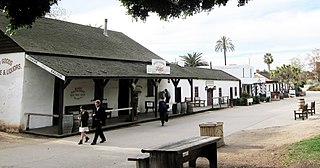
Old Town San Diego State Historic Park, located in the Old Town neighborhood of San Diego, California, is a state protected historical park in San Diego. It commemorates the early days of the City of San Diego and includes many historic buildings from the period 1820 to 1870. The park was established in 1968. In 2005 and 2006, California State Parks listed Old Town San Diego as the most visited state park in California.

El Presidio Real de Santa Bárbara, also known as the Royal Presidio of Santa Barbara, is a former military installation in Santa Barbara, California, United States. The presidio was built by Spain in 1782, with the mission of defending the Second Military District in California. In modern times, the Presidio serves as a significant tourist attraction, museum and an active archaeological site as part of El Presidio de Santa Barbara State Historic Park.

El Presidio Real de San Diego is a historic fort in San Diego, California. It was established on May 14, 1769, by Gaspar de Portolá, leader of the first European land exploration of Alta California—at that time an unexplored northwestern frontier area of New Spain. The presidio was the first permanent European settlement on the Pacific Coast of the present-day United States. As the first of the presidios and Spanish missions in California, it was the base of operations for the Spanish colonization of California. The associated Mission San Diego de Alcalá later moved a few miles away.

José Antonio Estudillo was a Californio ranchero, politician, and soldier, who served as Alcalde of San Diego and as San Diego County Assessor. He was a member of the Estudillo family of California, a prominent Californio family of San Diego.
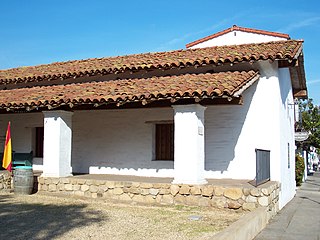
The Casa de la Guerra was the residence of the fifth commandant of the Presidio de Santa Barbara, José de la Guerra y Noriega, founder of the Guerra family of California from 1828 until his death in 1858. Descendants of José lived in the home until 1943. The site is currently owned and operated by the Santa Barbara Trust for Historic Preservation as a historic house museum. The address is 15 East De la Guerra Street, Santa Barbara, California.

The José Castro House, sometimes known as the Castro-Breen Adobe, is a historic adobe home in San Juan Bautista, California, facing the Plaza de San Juan. The Monterey Colonial style house was built 1838-41 by General José Antonio Castro, a former Governor of Alta California. It was later sold to the Breen family, who lived there until 1933, when the house became a museum as part of San Juan Bautista State Historic Park.

The Casa de Estudillo, also known as the Estudillo House, is a historic adobe house in San Diego, California, United States. It was constructed in 1827 by José María Estudillo and his son José Antonio Estudillo, early settlers of San Diego and members of the prominent Estudillo family of California, and was considered one of the finest houses in Mexican California. It is located in Old Town San Diego State Historic Park, and is designated as both a National and a California Historical Landmark in its own right.
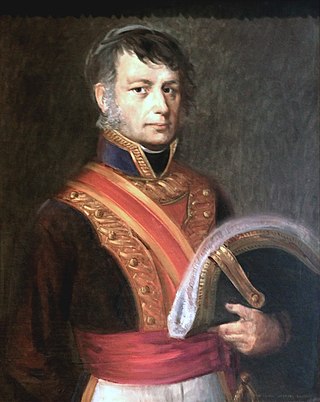
The Estudillo family is a prominent Californio family of Southern California. Members of the family held extensive ranchos and numerous important positions, including California State Treasurer, Mayor of San Diego, and Commandant of the Presidio of San Diego.

The José Serrano Adobe is a historic 1863 adobe house in Lake Forest, Orange County, California. The property is one of four historic buildings in the Heritage Hill Historic Park. It was listed on the National Register of Historic Places on May 24, 1976.
José Manuel Machado was a Spanish soldier, ranchero, early citizen and regiador on the ayuntamiento of the pueblo of San Diego.

The Covarrubias adobe is a California Historical Landmark in Santa Barbara, California. The house is one of the oldest in Santa Barbara, built in 1817. The adobe became a California State Historical Landmark No. 308 on September 12, 1939. The house is also on the Santa Barbara City Landmark. The house is located at 715 Santa Barbara Street. The house is a L-shaped with four rooms, the original Spanish tile roof was later replaced.
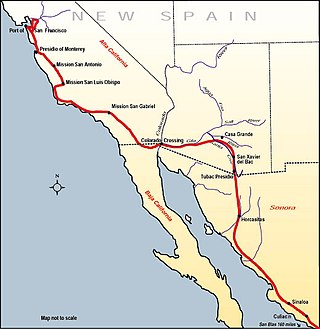
Fort Romualdo Pacheco also called Fuerte de Laguna Chapala was a Mexican fort built in 1825 and was abandoned a year later in 1826. The fort was 100 feet square with thick stone and adobe walls. The fort was built by Lieutenant Alfrez Jose Antonio Romualdo Pacheco Sr. in response to the attacked on travelers on the route made by Juan Bautista de Anza's expedition in 1774 from Sonora to Alta California. The fort was built after Fernando Rivera y Moncada, many of his soldiers, Francisco Garcés and his local missionaries, were killed at Mission San Pedro y San Pablo de Bicuñer in that is called the Yuma Revolt or Yuma Massacre on July 18, 1781. The attack was by the Apache Quechan Indians. The Yuma Massacre closed the overland transportation between northern Mexico and Alta California for 50 years. This halted the immigration of Mexicans to Alta California. Lieutenant Pacheco with soldiers and cavalry from the Presidio de San Diego built the fort in later 1825 and early 1826. The fort was built just north of the New River and south of the Bull Head Slough in what is now Imperial, California. The Fort was only used for a few months in 1826. Pacheco returned to San Diego and put Ignacio Delgado in charge of the Fort. On April 26, 1826 the San Sebastian Kumeyaay Indians attacked the fort. Pacheco had heard about rumors of the attack and arrived during the attack with reinforcements from San Diego. Pacheco and his 25 lancers fought off the attack. In the battle, three soldiers were killed and three injured. In the battle, 28 Indians were killed. But, now the fort was surrounded by many Kumeyaay and Quechan warriors. Vastly outnumbered the Fort was abandoned and all returned to San Diego. Archeologists did digs at the site in 1958 before Imperial Valley College Museum removed the remains.
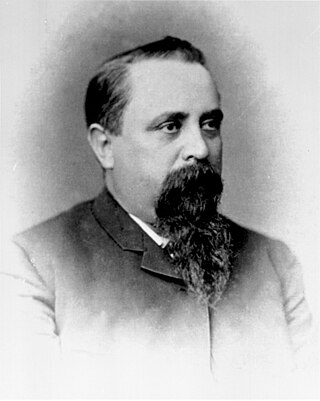
The Sepúlveda family is a prominent Californio family of Southern California. Members of the family held extensive rancho grants and numerous important positions, including Alcalde de Los Ángeles, California State Assemblymen, and Los Angeles County Supervisor.

Casa de Carrillo House in San Diego, California in San Diego County, is a California Historical Landmark No. 74 listed on December 6, 1932. The Casa de Carrillo House is the oldest residence in San Diego. The Casa de Carrillo House was built by Presidio of San Diego Comandante Francisco María Ruiz (1754–1839). Ruiz was the leader of the Presidio from 1809 to 1827. The Casa de Carrillo house was built next to his pear orchard planted in 1808. The Adobe house was used by his relative and soldier, Joaquín Carrillo, and his family. Joaquín Carrillo, daughter Josefa Carrillo, ran away and sailed from the home and eloped to Chile with Henry Delano Fitch in April 1829. Francisco Ruiz died in 1839, when Joaquín Carrillo died, his son Ramon Carrillo sold the house and land to Lorenzo Soto. The house and land was sold a few times, it was poor condiction when sold in 1932 to George Marston and associates. George Marston and associates restored the house. After the restoration George Marston and associates donated the house and land to the City of San Diego. The City of San Diego turned the house and land into the Presidio Hills Golf Course.
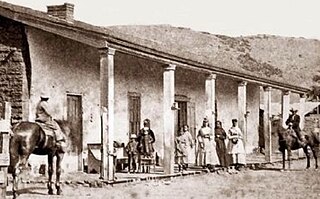
Casa de Lopez was a historical Adobe building in San Diego, California built in 1835. The Casa de Lopez site is a California Historical Landmark No. 60, listed on December 6, 1932. Casa de Lopez, often called the long House, built by Juan Francisco Lopez, a Spanish settler of San Diego. Casa de Lopez was one of the first large houses built in San Diego. Juan Matias Moreno lived in the house starting in 1846. Juan Matias Moreno as the secretary to 10th Governor of Alta California, Governor Pío Pico, the last Mexican governor. The house, with a current address of 3890 Twiggs Street, is now a restaurant in Old Town, San Diego. A Historical marker is on corner of Twiggs Street west of Congress Street built by the California State Park Commission.

Casa de Machado, also called Casa de Machado y Silvas is a historical Adobe building in San Diego, California built in 1832. The Casa de Lopez site is a California Historical Landmark No. 71, listed on December 6, 1932. Casa de Machado was built by José Manuel Machado, pioneer leatherjacket company soldier of the New Spain Army stationed in San Diego. He arrived at the San Diego Presidio in 1782 when he retired. José Manuel Machado built a house, Casa de Stewart, for his daughter Rosa, she married Jack Stewart. Stewart from Maine and was pilot boat operator in Maine. The Stewarts enlarged the house. Carmen Stewart Meza lived in the house for some years. The 1850s it was a Commercial Restaurant. 1930s, The Machado y Silvas family owned the house until the 1930s. In the 1930s and early 1940s the house was rooming-house, café, art studio, and souvenir shop. In 1942 the house became a church, Machado Memorail Chapel. Casa de Machado was acquired by California State Parks in 1968, who had it restored. The Casa de Machado y Silvas house's current address, 2737 San Diego Avenue, in Old Town, San Diego.
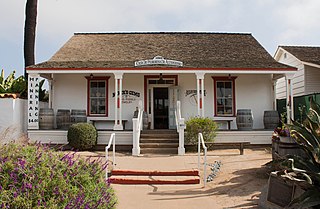
Casa de Pedrorena, also called Altamirano-Pedrorena House is a historical Adobe building in San Diego, California built in 1869. The Casa de Lopez site is a California Historical Landmark No. 70, listed on December 6, 1932. Casa de Pedrorena was the home of Miguel de Pedrorena. In 1838 Miguel de Pedrorena arrived in San Diego Viejo. Don Miguel was a member of the California Constitutional Conventions at Monterey, California in 1849. Monterey Convention of 1849 was the first California Constitutional Convention to take place, a major decidion of the convention was to ban slavery and set state boundaries. Pedrorena sister, Isabel de Altamirano, received the house in January 1871. Isabel de Altamirano married Jose Antonio Altamirano and they raised their family here. Jose Antonio Altamirano was born in 1835 in La Paz, Baja California. Jose Altamirano arrived in San Diego in 1849. In San Diego he did some mining and raised cattle in San Diego and Baja California. The house's current address, 2616 San Diego Ave in Old Town, San Diego. Casa de Pedrorena is the newest and last of Old Town San Diego's adobe houses.

El Desembarcadero, or the The Landing is a historical site in San Diego, California in San Diego Bay. The El Desembarcadero site is a California Historical Landmark No. 64 listed on December 6, 1932. It is the site of the landing by Spaniards coming to New Spain, the site is in that is now Old Town, San Diego. Small ship's boats brought cargo and passengers to the San Diego Mission, Presidio of San Diego and Pueblo San Diego. It most likely that ships San Antonio and San Carlos landed at the site in 1769, loooking fresh water on the San Diego River, on their San Diego expedition. San Antonio arrived in San Diego Bay on April 11, 1769, and the San Carlos on April 29. They landed on May 1, 1769, Some of the ships grew died in San Diego and Father Serra and Father Vila, remain in San Diego. T

La Punta de Los Muertos, also called Sailors, Dead Men's Point is a historical site in San Diego, California. La Punta de Los Muertos site is a California Historical Landmark No. 57, listed on December 6, 1932. The site is thought to be the burial site of those that died in the survey party of Don Juan Pantoja y Arriaga and Don José Továr in 1782. Don Juan Pantoja y Arriaga arrived at San Diego Bay on the Spanish Empire Royal frigate La Princesa built in 1778 and with the La Princesa was the frigate ship La Favorita. The ships were under the command of Don Augustín de Echeverria or Esteban José Martínez. La Princesa was under Agustín de Echeverría and Josef Tovar. Some sailors on the ships most likely died from scurvy or an intestinal disease, from lack of fresh food on the trip to San Diego. Esteban Martínez and Pantoja was also on the trip. Don Juan Pantoja was the leader of the San Diego Bay survey party, called the Pantoja voyage. The site is now a city shopping mall and Ruocco Park, near the San Diego Police Museum.
























